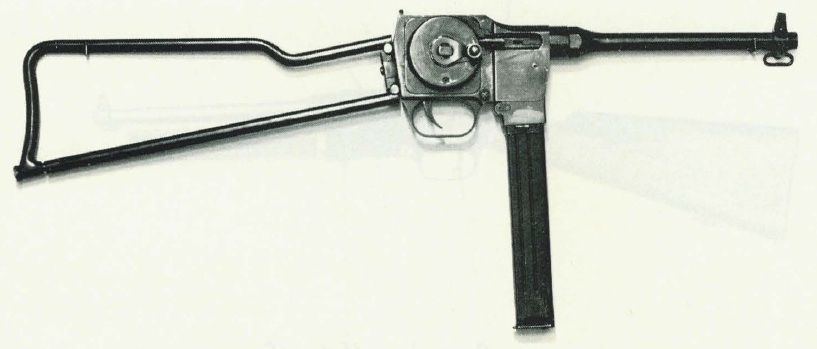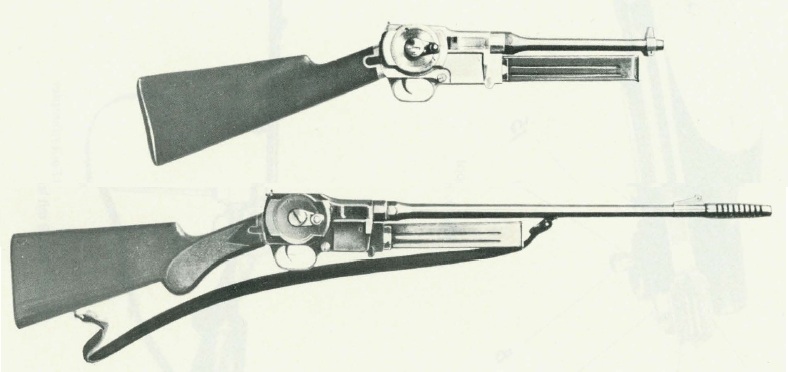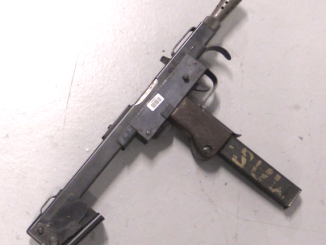The PM9 was an interesting an unique submachine gun designed by Louis Debuit for the French firm Merlin and Gerin (hence the MGD name – Merlin, Gerin, Debuit) in the late 1940s and early 50s. The design was intended to provide a very compact package, which it did with a very short action, folding stock, and folding magazine.

The PM9 uses a delayed blowback action, and the delaying is done by a rotating flywheel-type block and clock spring. The bolt and flywheel act somewhat like the piston and crank in an engine. As the bolt (piston) moved rearward in a straight line, it forces the flywheel (crank) to rotate because the two are connected. In the case of the PM9, the connection is a nub on the flywheel that rides in a vertical slot in the bolt. The flywheel is pushing against the clock spring to rotate, and the combination of the its inertia and spring pressure keep the bolt closed long enough for pressure to drop to a safe level. The rotary action allows this to be done in a much smaller package than typical submachine guns.
The PM9 was initially chambered for 7.65 French Long, but quickly changed to standard 9mm Parabellum for the production models. It used the same magazine as the German MP38/MP40, giving it a 32-round capacity. In addition to the model with a skeletonized folding stock, the PM9 was also available with a fixed wooden stock and either short barrel of long carbine barrel. A relatively small number of guns were produced in France in 1954 and 1955, but they failed to find commercial success. In 1956 the German Erma company acquired a license to build the PM9, but abandoned the idea after making a few prototypes.

We have a copy of an article on the PM9 from Waffen Revue and a copy of Debuit’s US patent available on the Erma / MGD PM9 page in the Vault, if you would like to see more detailed internal pictures and description of the gun.




That looks a very unique design. Know of any other weapons that did the same? I presume lack of sales and further project were due to the it being a lesser design.
As Gerard said, a very unique design, although I’m not sure if the lack of commercial success necessarily had anything to do with an inferior design per se. History is rife with otherwise excellent and technically-superior weapons failing to achieve acceptance due to a host of other factors, or combination thereof, ranging from miguided marketing, entrenched and close-minded potential clientele and bad introductory timing ( classic example — “too far ahead of its time” ) to non-standard caliber, unconventional layout and logistical re-equipment issues.
In that light, does anyone have any additional technical information regarding the reliability and performance of the MGD that may have possibly affected its acceptance into general service?
Read “misguided” for “miguided” — Sorry about the typographical error.
I agree with Earl Liew. Some guns technically are masterpiece designs, but are made in wrong place, wrong time, suffer from poor introduction and promotion, don’t look “cool” … all mentioned combined results in commercial failure. Nowadays the vice versa also happens … pretty frequently you can see a newly revealed guns which people become so mad about because of excellent marketing tricks … but if you look closer and with fresh mind you can see that it is nothing else but some other gun’s copy or have no significant advantages or improvements as it is advertised to.
Hrachya brought up a very good additional point about the part perception plays in what sells and what doesn’t — the truimph in many quarters of the “cool” factor, driven by marketing expertise, over real form and function.
Witness the many websites dedicated to so-called “tacti-cool” weaponry and the many devotees of the genre. Before someone accuses me of bigotry regarding this issue, I will say that I have no problem with such preferences on anyone’s part ; as a matter of fact, I personally own quite a few customized tactical weapons in different calibers, and both enjoy and appreciate them to the fullest degree.
My reservations concerning the “tacti-cool” genre as a whole is the loss of reason and perspective that seems to pervade much ( but not all ) of that particular area of interest. One has only to read the many posts involving one-upmanship to understand this.
I think that timing was a major factor in this weapon’s demise, on two counts, and “1958” — the year on the patent — is why:
1. It came onto the market right as pistol-calibre SMGs were beginning to lose mindshare to intermediate-calibre rifles, and faux-intermediate NATO calibre rifles. The USA had just adopted the M14 which, on paper, was to replace the M3 SMG, M1 Carbine, M1 Rifle, BAR, and some M1911 pistols and M1919A6 LMGs. (This was madness to the barking degree — the M14 is actually larger than the M1 in most dimensions — but that’s how the concept was sold). Other armies were doing similar things. Russia was replacing PPSh and !891/30 alike with AKs; Germany going to the FAL, then G3; and so on.
2. It came into the market right as a huge glut of nearly free WWII weapons were available, some used, and some surplus, stored, new. Norway, for instance, was still using some Mausers and MP40s until the 1980s…you could not have sold the Norwegian MOD on another 9mm SMG unless it offered real advantages. (They finally bought MP5s and retired the MP40s, even from the Home Guard). That’s just one example.
A new gun not only has to be better than its competition in today’s market, it has to be better than what the service it’s offered to is using now. And it can’t be just a little bit better, because it has to be superior enough to justify the opportunity costs of the expenditure. By that, I mean, it has to be better than whatever ELSE the MOD in question can do with the procurement money.
I think that Kevin O’Brien’s excellent analysis is true and correct. Speaking of the opportunity costs of expenditure, a classic modern example would be the case of the venerable Browning M2HB .50-caliber HMG ; remember the slew of new-generation HMG’s that briefly came to the forefront in the 1980’s? The tubular-framed AAI GPHMG, CIS-50 and “Dover Devil” were all supposed to provide better alternatives to the Browning but failed to gain service acceptance ( except for the CIS-50, which was adopted in limited quantities by the Singapore Armed Forces ) for precisely that reason. The result has been minor modifications, such as a quick-change barrel with fixed head space ) to the M2HB in an effort to update its effectiveness on the modern battlefield.
I agree with Kevin O’Brien analysis, but given the fact that the French army had just adopted a new pistol-calibre SMG developed by the Manufacture Nationale d’Armes de Tulle (the MAT 49) at about the same time as the PM9 was being proposed, I wonder how well (or how badly) did the later fare against the former. The period between the late Forties and the mid Fifties was one of intense experimentation in France in what regarded automatic weapons, with several guns being considered for the SMG niche; the French armed forces and the Gendarmerie were still quite interested in such guns because they didn’t adopt selective fire assault rifles chambered for an intermediate round until much later (despite their pioneering work during the Great War, the French stuck to semi-autos in 7,54×54 until the FAMAS adoption). Some French SMGs from the immediate post-WW II era were unusual and even innovative but after failing against their main domestic rival (the MAT 49) and being pistol-calibre SMG in a brave new world flooded with cheap WW II surplused stocks and slowly but steadily adopting new battle and assault rifles, they didn’t fared well in the export markets either. Hotchkiss, for instance, had an interesting collapsible design, the PM Mle CMH2; the French military found its concept neat but unnecessarily complicated for a service weapon. Nevertheless, it was tested in Indochina (the batch produced was eventually sold to Venezuela). MAS designed a more conservative SMG also evaluated under operational conditions in Indochina, the PM MAS 48. I am not sure about the PM9, but it might have been tested in SE Asia as well (or maybe in Algeria).
Ruy Aballe’s post about the state of the post-war French small arms market and its impact on the SMG in particular were most interesting. I certainly learned a lot from reading his comments. Many thanks to him and to Kevin O’Brien for sharing their perspectives on this subject, and to Ian for providing this wonderful forum.